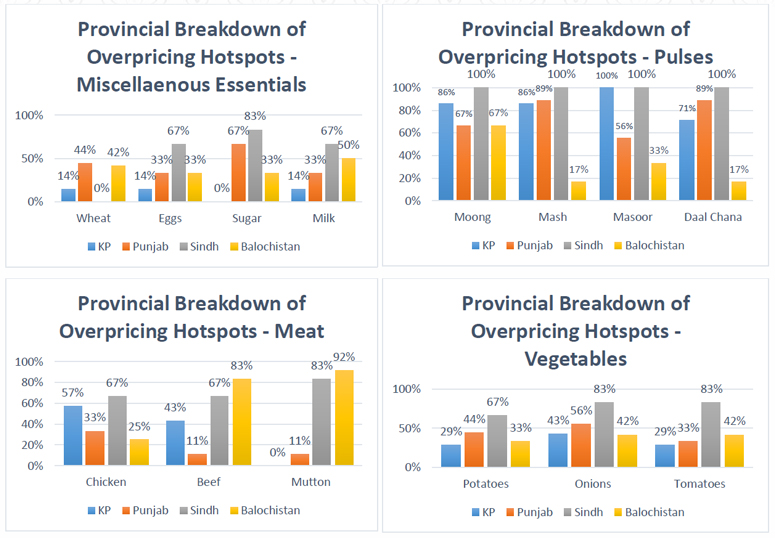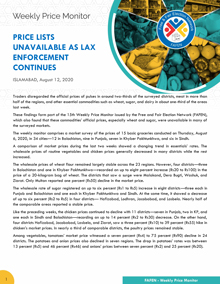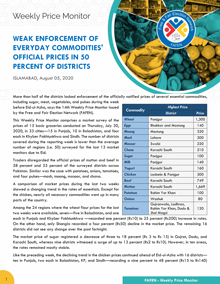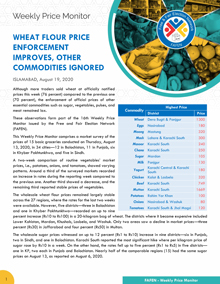ISLAMABAD, August 12, 2020: Traders disregarded the official prices of pulses in around two-thirds of the surveyed districts, meat in more than half of the regions, and other essential commodities such as wheat, sugar, and dairy in about one-third of the areas last week.
These findings form part of the 15th Weekly Price Monitor issued by the Free and Fair Election Network (FAFEN), which also found that these commodities’ official prices, especially wheat and sugar, were unavailable in many of the surveyed markets.
The weekly monitor comprises a market survey of the prices of 15 basic groceries conducted on Thursday, August 6, 2020, in 34 cities—12 in Balochistan, nine in Punjab, seven in Khyber Pakhtunkhwa, and six in Sindh.
A comparison of market prices during the last two weeks showed a changing trend in essentials’ rates. The wholesale prices of routine vegetables and chicken prices generally decreased in many districts while the rest increased.
The wholesale prices of wheat flour remained largely stable across the 23 regions. However, four districts—three in Balochistan and one in Khyber Pakhtunkhwa—recorded an up to eight percent increase (Rs20 to Rs100) in the price of a 20-kilogram bag of wheat. The districts that saw a surge were Malakand, Dera Bugti, Washuk, and Ziarat. Only Multan reported one percent (Rs50) decline in the market price.
The wholesale rate of sugar registered an up to six percent (Rs1 to Rs5) increase in eight districts—three each in Punjab and Balochistan and one each in Khyber Pakhtunkhwa and Sindh. At the same time, it showed a decrease of up to six percent (Rs2 to Rs5) in four districts— Hafizabad, Lodhran, Jacobabad, and Lasbela. Nearly half of the comparable areas reported a stable price.
Like the preceding weeks, the chicken prices continued to decline with 11 districts—seven in Punjab, two in KP, and one each in Sindh and Balochistan—recording an up to 14 percent (Rs2 to Rs30) decrease. On the other hand, four districts Hafizabad, Jacobabad, Lasbela, and Ziarat, saw a three percent (Rs10) to 39 percent (Rs55) hike in chicken’s market prices. In nearly a third of comparable districts, the poultry prices remained stable.
Among vegetables, tomatoes’ market price witnessed a seven percent (Rs4) to 75 percent (Rs90) decline in 24 districts. The potatoes and onion prices also declined in seven regions. The drop in potatoes’ rates was between 13 percent (Rs5) and 46 percent (Rs46) and onions’ prices between seven percent (Rs2) and 25 percent (Rs20).

The officially notified price lists of essential commodities were unavailable in various parts of the country during the reporting week. The official rates of 20-kilogram wheat flour bags were not available in more than half (56 percent) of the surveyed cities. The unavailability of official wheat flour rates at shops was the most significant in Khyber Pakhtunkhwa and Sindh, where 86 percent and 100 percent of the districts lacked the official prices.
The official sugar prices were missing in 44 percent districts—100 percent in KP, 33 percent in Balochistan and Punjab, and 17 percent in Sindh. Similarly, the chicken prices were not obtainable in 29 percent regions overall—58 percent in Balochistan, 33 percent in Sindh, and 14 percent in Khyber Pakhtunkhwa. However, all of the surveyed areas of Punjab displayed the official chicken rates. The official rates of four pulses—moong, masoor, mash, and chana—were generally available in KP, Punjab, and Sindh. However, more than half of Balochistan’s surveyed cities’ markets did not display the official prices of mash and masoor. Another 33 percent did not display daal chana rates and 17 percent daal moong prices. At the same time, milk and yogurt prices were not publicly obtainable in 18 percent and 26 percent areas.
Moreover, mutton and beef prices were missing in 15 percent and 12 percent of the districts. Provincially, the meat prices were not available in 17 percent of Sindh’s areas, 11 percent in Punjab, and 43 percent in KP. However, all of the surveyed Balochistan markets prominently displayed the meat prices. The official price lists of regular vegetables—potatoes, onions, and tomatoes—were inaccessible in around a third of the Balochistan markets while elsewhere they were publicly available.
The lax enforcement of official prices burdened the ordinary citizens as traders sold several commodities at higher rates than the officially notified prices.
The weak enforcement of the official prices of vegetables, pulses, and meat continued during the reporting week. Pulses’ prices were the most unregulated in many parts of the country. Daal moong was overpriced in 76 percent of the surveyed districts, masoor and mash (65 percent), and chana (62 percent) of the areas. These four pulses went Rs108 to Rs170 above the official prices. The highest difference in wholesale prices and the official rates was in Karachi South and Nowshera. Although the pulses’ overpricing was common across provinces, it was most notable in Sindh, where no market sold any of the four pulses at official prices.
Potatoes, onions, and tomatoes were overpriced in 41 percent, 53 percent, and 44 percent districts. The tomatoes rate went Rs100 higher than the notified price in Jhal Magsi, while potatoes and onions were sold Rs60 and Rs30 above the announced prices in Panjgur.
In the meat category, beef and mutton (average quality with bone) were overpriced in 53 percent and 50 percent of the surveyed districts, and chicken in 41 percent. Mutton, beef, and chicken were sold at Rs929, Rs449, and Rs100, respectively, above the official rates. The highest difference in the market and the official prices of mutton and beef was in Karachi South and chicken in Panjgur.
Traders sold wheat flour and refined sugar above the official rates in 29 percent and 44 percent districts. A 20-kilogram bag of wheat flour was priced Rs350 above the official rate in Washuk, and one kilogram of refined sugar Rs31 more than the market price in Karachi’s Malir district. Wheat price enforcement was the weakest in Punjab and Balochistan, where 44 percent and 42 percent markets, respectively, sold it above the officially notified rates. The sugar price enforcement was the weakest in Sindh, where around 83 percent of markets sold it above the official prices. It was followed by Punjab (67 percent), and Balochistan (33 percent). However, KP markets mostly followed the official prices.
The market rates of eggs per dozen were above the officially notified prices in 35 percent districts, whereas the prices of milk and yogurt were higher than the official ones in 41 percent of the surveyed areas.
This interactive graph may be used to view the percentage of areas where official prices of essential commodities were missing.
TDEA-FAFEN generates the Weekly Price Monitor covering 15 essential kitchen items, including wheat, pulses, oil, sugar, and perishable commodities like meat, and vegetables. It does this considering the need for an independent and regular assessment of the availability of such items.
The observers obtain the official prices from the officials of district administrations, or market committees, and collect the wholesale prices through market surveys. In Punjab’s case, the government price app Qeemat Punjab is also used to get the official rates.
To download the report, click here




